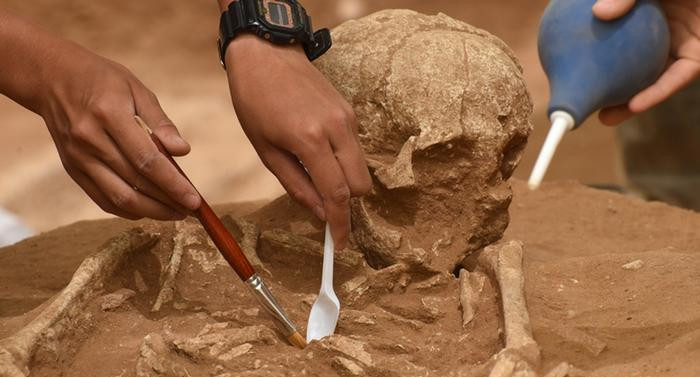The surgery for piercing the skull was 3,000 years ago
Russian scientists found patients to be anesthetized with marijuana and magic mushrooms before the skull drill surgeon from 3,000 years ago.
According to RT, studying the skull of a Bronze-era man helped shed light on how ancient residents in northern Russia's Krasnoyarsk treat diseases inside the skull.
In a study published on August 1 in the International Journal of Bone Archeology, scientists point to natural brain stimulants such as magic mushrooms, marijuana and even drumming to help relieve pain. caused by primitive surgical instruments.

The skull of a man buried in the burial area of Anzhevsky, Russia, has traces of cranial surgery.(Photo: Reuters).
Discovered at the burial site of Anzhevsky last year, the skull dates to about 3,000 years with a large hole in the left parietal lobe. Scientists believe the hole is the result of a relatively successful bone or bone augmentation surgery in ancient times.
According to Dr. Sergey Slepchenko at the Institute of Archeology and Ethnology in Novosibirsk, the patient survived the skull drilling process but died later due to complications in the recovery period. Slepchenko says the skin outside the skull is peeled off before surgery and an assistant helps the doctor shave bones.
"One of the most dangerous complications when drilling the skull is the bleeding immediately after slitting through the skin," Dr. Slepchenko said. "To limit bleeding and pain relief, surgery needs to be done as quickly as possible by a skilled doctor. We don't know how they can stop the bleeding."
Skull drilling techniques are quite common in some ancient civilizations. 2016 study by scientist Julia Gresky at the German Archaeological Institute found evidence of prehistoric brain surgery in southern Russia. The remains of 13 individuals from the Bronze Age have identical skull marks. Gresky concludes that most of them still live a long time after surgery.
- Mysterious skull surgery 2300 years ago
- New discoveries in Peru reveal the possibility of the Inca skull surgery
- Brain surgery can take place 3,000 years ago
- Technical details of
- 'Artificial' doctors perform brain surgery super fast, only 2.5 minutes instead of 2 hours
- The world's first skull transplant
- For the first time, brain tumors do not open the skull
- The baby was born with a part of the brain outside the skull saved
- Surgery for brain tumors requires no separation of the skull
- Netherlands: Successfully implanted 3D skull for a woman
- How to perform 'body grafting' from scary to modern
- Detecting skulls dating to 430,000 years old
 Discovered an ancient centipede fossil 99 million years old
Discovered an ancient centipede fossil 99 million years old Discovered bat-like dinosaurs in China
Discovered bat-like dinosaurs in China Discovered a 200-year-old bronze cannon of the coast
Discovered a 200-year-old bronze cannon of the coast Discover 305 million-year-old spider fossils
Discover 305 million-year-old spider fossils